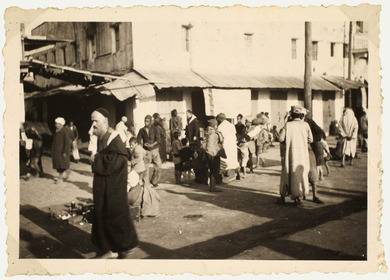Casablanca
After the occupation of France in 1940 and the division of the country into an occupied and a free zone, the travel route of many refugees who wanted to go overseas shifted by necessity to the African continent. With the French ports on the Atlantic under German control and restrictive transit regimes in Spain and Portugal, people wishing to leave Europe frequently had no choice but to depart via the last free port in Marseille, from whence most ships sailed to the Vichy-controlled colonies and protectorates. For geographical reasons, the Moroccan capital of Casablanca became the most important transit through-point in Africa.
Onward travel from there was complicated, however, by the fact that there were no official contact bureaus for the refugees and the offices of relief organisations had been closed by police in mid-1941. Moreover, at this point there were few ships crossing the Atlantic. Nevertheless, organisations like the Centre Américaine de Secours, the Unitarian Service Committee, HICEM and the Joint Distribution Committee did attempt to arrange trans-Atlantic transport for as many people as possible via contact people in Casablanca. In some cases, refugees were obliged to travel to Cuba, Mexico or the Dominican Republic in freight vessels. The US had tightened its immigration rules, and only after protestations by the relief organisations could several hundred refugees from Casablanca be taken there.
People who became stranded in Morocco due to visa problems or expired exit papers from Vichy France, ran the risk of being interned along with the refugees brought to North Africa from its internment camps by the French government in 1940. The prisoners were obliged to do forced labour, for instance for the Trans-Saharan Railway.
When the German Wehrmacht expanded their occupation to southern France and destroyed the old city of Marseille in January 1943, ship traffic between the port city and North Africa ceased.
Weiterführende Literatur:
Anne Klein: Flüchtlingspolitik und Flüchtlingshilfe 1940-1942. Varian Fry und die Komitees zur Rettung politisch Verfolgter in New York und Marseille. Berlin: Metropol 2007



